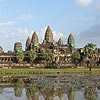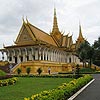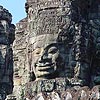Cambodia Tours

Cambodia has a land area of 181,035 square kilometers in the southwestern part of the Indochina peninsula, about 20 percent of which is used for agriculture. It lies completely within the tropics with its southern most points slightly more than 10° above the Equator. The country capital city is Phnom Penh. International borders are shared with Thailand and the Lao People's Democratic Republic on the West and the North, and the Social Republic of Viet Nam on the East and the Southeast.

The country is bounded on the Southeast by the Gulf of Thailand. In comparison with neighbors, Cambodia is a geographical contact country administratively composed of 20 provinces, three of which have relatively short maritime boundaries, 2 municipalities, 172 districts, and 1,547 communes. The country has a coastline of 435 km and extensive mangrove stands, some of which are relatively undisturbed.

The population of Cambodia today is about 10 million. About 90-95 percent of the people are Khmer ethnic. The remaining 5-10 percent include Chinese-Khmers, Khmer Islam or Chams, ethnic hill-tribe people, known as the Khmer Loeu, and Vietnamese. About 10 percent of the population lives in Phnom Penh, the capital, making Cambodia largely a country of rural dwellers, farmers and artisans.

The divergent facets of the Kingdom provoke both the serious and casual traveler, generally charmed and sometimes bewildered by its mysteries. Not only Angkor Wat, Bayon, Taprohm, Sandstone of ancient holy places, the giant roots of ancient trees, the graceful shapes of Apsaras and some temples buried in the jungle, hill tribes settled in the remote areas, colorful pagodas, strings of pristine islands and the century beach, as part of cultural tour that Cambodia is proud of her presentation, but also the splendor of the Khmer civilization and its people who have shown their friendliness everywhere you move in the country.
Every year, the country is transformed in a nature cycle, which is unique to Cambodia. The flow of the mighty Mekong River swells until it forces the Tonle Sap to reverse its course, pushing up stream from the ancient capital. Every year, the reversal of the river is celebrated with the country's most spectacular Water Festival in November.


